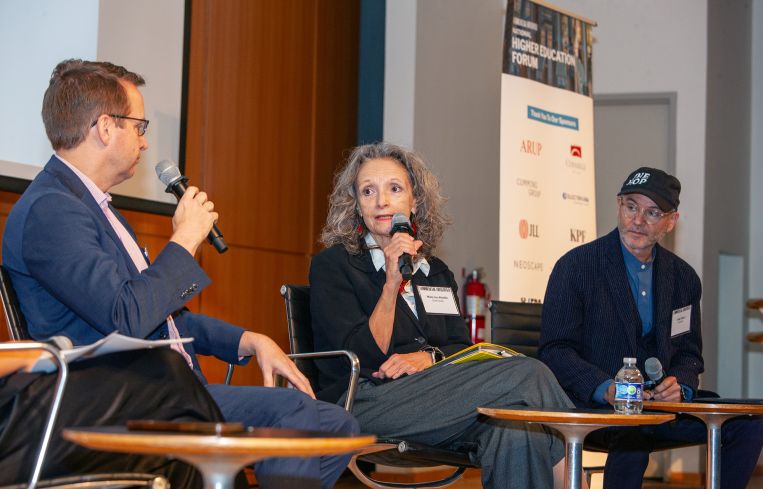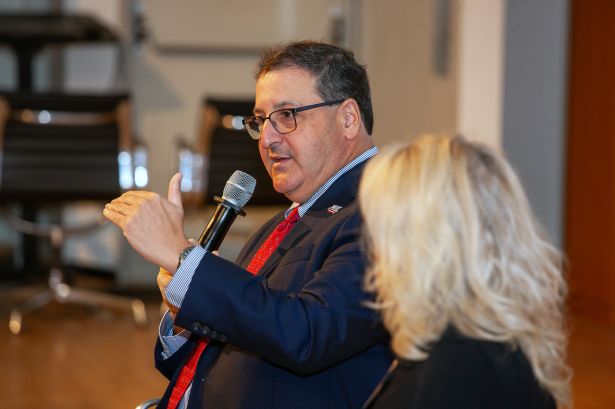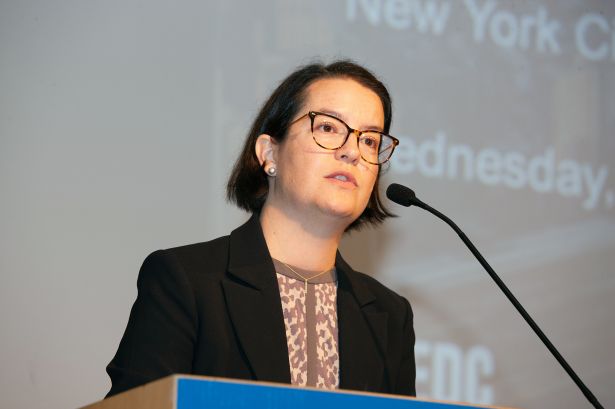Higher Ed Construction and Design Forum Gives High Marks to Innovation
Funding crunches and shifting fundamentals make change a near constant, experts at a recent Commercial Observer forum said
By Larry Getlen October 10, 2025 10:22 am
reprints
While kicking off Commercial Observer’s National Higher Education Forum on Oct. 8 at the City University of New York Graduate Center in Manhattan, Natalie Sachmechi, an associate in the nonprofit, education and government practice at JLL, primed attendees with a blunt assessment of the state of that segment of the commercial real estate industry.
“The last couple of years have been pretty difficult for our industry,” said Sachmechi, who served as the event’s emcee as well as a panel moderator. “Higher eds are facing enrollment challenges. One college or university is closing or merging every week. We see that across the country. We see it here in New York. We see it a lot in the Northeast.”
This, said Sachmechi, is why events like CO’s forum have such value, as they allow the real estate industry in the higher ed sector to actively discuss difficult situations and possible solutions.
“It’s more important than ever for us to get together to talk about what we can do about it,” said Sachmechi. “Real estate is an excellent tool for higher eds to use to invite the modern student and reimagine their campuses, reimagine historic buildings, enhance their programming, and retain faculty and staff, and that’s a lot of what we’re going to be talking about today.”
The program began with a keynote discussion between moderator Jimmy Kuhn, president and head of the university practice group at Newmark; R.J. Panda, vice president at project manager Cumming Group; and James Kellerhouse, assistant vice chancellor for strategic initiatives and executive director of operations at Vanderbilt University, which recently signed a lease with the General Theological Seminary for a New York City campus in Chelsea that was the subject of the discussion that followed.
Kellerhouse noted that for universities today, money from tuition, room and board often isn’t enough to sustain operations. Educational institutions, therefore, need to be creative and flexible.
“When you think of New York City, we have mission-specific business revenue from tuition, room and board. We’ve got philanthropy, and then we also have external events,” said Kellerhouse. “So our campus at the seminary is a venue. It generates revenue. We have weddings, corporate events, galas, runway shows, those types of things. When you’re thinking about growth, you have to be thinking differently about your business model. Higher ed can’t do it anymore on just tuition.”
Next came a panel on designing innovation hubs that bridge higher education with industry. Sean Scuderi, partner and vice chair at law firm Tarter Krinsky & Drogin, moderated a discussion that included Claudia Cusumano, principal at architecture firm KPF; Charles Esteves, director of preconstruction at construction firm Consigli; Christine Galib, director of advancing photonics technologies at Princeton; and Ivy Schultz, director of entrepreneurship at Columbia.
Given the rapid pace of technological and cultural change, the panel emphasized the importance of doing what it takes to future-proof designs.
“You can start by fighting with the utility companies to get the right electric service to the building on day one,” said Cusumano. “Everybody’s either all-electric or electric-ready. The grids aren’t prepared for it, but we’re looking forward there, certainly from a sustainability perspective.”

Cusumano also emphasized the importance of a free flow of ideas in considering innovation concepts for the future.
“It’s an incredibly weighty task [to consider]: What does innovation mean today, and what is it going to mean in the future?” said Cusumano. “You get the best consultants and free-thinkers from the university, and let the professionals have some blue sky thinking in the beginning. Put everything on the board and consider: What can we plan as expansion space in 10 years?”
Adaptive reuse, and campus expansion in tight places, was the topic of a talk between Jensen Ambachen, general counsel at the City University Construction Fund; Maey Khaled, senior director for campus planning and technical services at New York University; and moderator Stuart Rosen, partner at Tannenbaum Helpern.
The panelists emphasized how, when planning best uses of existing infrastructure in New York City, making use of every available square foot is paramount.
For Khaled and NYU, blending a desire to optimize with respecting strong infrastructure is key.
“Adaptive reuse is basically what NYU has been doing, specifically for the School of Engineering at our campus in Downtown Brooklyn,” said Khaled. “A lot of our buildings are old factory buildings. We look at the bones.”
This was a significant consideration in the university’s redevelopment of 6 MetroTech Center.
“Infrastructure is what drove all the planning, not the other way around. We knew the building had good bones,” said Khaled. “We knew it can support the heavy research load that was required. It was just a matter of getting the pieces in place to execute on that. That’s the challenge of New York City. Adaptive reuse comes with how creative can you get.”
For a talk on how athletic facility design shapes campus life, Lenny Kaplan, vice president/director of athletics at the New Jersey Institute of Technology, spoke with moderator Tasha Stancill, senior account director at branding agency Neoscape.
Kaplan, who has been at the institute for 26 years, spoke about how he spearheaded construction of a 225,000-square-foot athletic facility as part of its quest to transition from Division 2 to Division 1 sports despite limited funds and space.
“We wanted people who were not afraid to be creative because of our limited size. Just like in New York, we had to go up. There was no spreading out,” said Kaplan. “It’s built in four quarters, and each quarter is different. The arena goes from the floor all the way up to the top. The pool goes down and stops at the end of the second floor, and then the third floor is the baseball hitting facility. The offices, fencing room, and one of the strength rooms is three floors. So it was a lot of moving parts to get that done.”
For a panel on designing spaces that shape student life, Megan R. Abraham, CEO of nonprofit The Goldie Initiative, moderated a discussion with Marcus Caamaño, director of design and construction for the division of facilities and campus operations for the Stevens Institute of Technology; Mary Mahany, senior project executive at Shawmut Design and Construction; and Andrew Repoli, director of global facilities and construction management at NYU.
The panelists discussed the importance of sustainability in today’s educational environment.
“Wellness and sustainability are topics that touch every one of our capital construction projects,” said Repoli. “We always have very robust discussions about it when we’re in the planning process. Every one of our projects could meet a LEED Silver standard, and our 370 Jay Street renovation project in Brooklyn got LEED Platinum.”
Caamaño noted that these actions actively assist in recruitment.

“Speaking with our student affairs and enrollment management departments, a lot of this is what [students are] looking for,” said Caamaño. “Students will actually base their college decision on the sustainability of the campus and the carbon-neutral goal, or the decarbonization plan that they have set forth.”
A keynote speech followed by Cecilia Kushner, executive vice president and chief strategy officer at the New York City Economic Development Corporation, who gave a brief but detailed introduction to her organization and its many accomplishments.
Kushner noted that the NYCEDC has “64 million square feet under management across 200 properties, and 179 capital projects in progress with a $9 billion capital budget.”
She discussed how NYCEDC led the charge in bringing the city back to life after COVID-19, and how, despite beliefs to the contrary, New York has not only survived, but thrived in record numbers.
“We are at record high job numbers in New York City,” said Kushner. “We have more than 4 million private sector jobs, and it’s working so well that people are moving back to New York City. Last year, we had the fastest-growing population in the country. We added 84,000 New Yorkers. That’s more than Dallas, Atlanta and Miami combined. We are the nation’s top destination for young talent.”
Finally, the last panel of the morning took a deep dive into the two-and-a-half-year, $123.8 million renovation and expansion of the Hopkins Center for the Arts at Dartmouth College in New Hampshire.
JLL’s Sachmechi moderated a panel that included Mary Lou Aleskie, the Howard Gilman `44 executive director and chair of the advisory council for arts, advancement and integration at Dartmouth; Craig Dykers, founding partner at architecture firm Snøhetta; and Joe Solway, principal at engineering firm Arup.
In walking the attendees through the project, Aleskie and Dykers left the audience with a few valuable thoughts about the nature of accomplishment.
“Like all great things in the world, I think things happen because the right people end up in the right place at the right time,” said Aleskie, as she mentioned that the day the school was about to sign its contract with Snøhetta was the day they had to leave their offices due to COVID.
“I would be lying if I said the trustees didn’t take a deep breath and pause for a moment,” said Aleskie. “And we all went, ‘No, no, no. This is the time.’”
Dykers then responded that early in his career he was hired to revive the Great Library of Alexandria in Egypt. At first, many responded by asking, “Why now?”
“There’s never a good time,” said Dykers about initiating ambitious projects. “It’s like having a baby. You just have the baby, and it’ll be a good time after the baby is born. If you try to think too much into it, that whole future gets washed away. Asking yourself ‘Why now?’ is less valuable than asking, ‘What will the future be?’”
Larry Getlen can be reached at lgetlen@commercialobserver.com.


